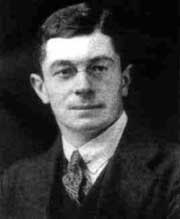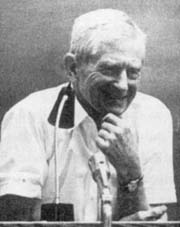Sydney Chapman
Written by Keith B. Mather after Chapman's death in 1970.

Dr. Sydney Chapman was professor of geophysics and advisory scientific director of
the Geophysical Institute of University of Alaska Fairbanks from 1951-1970.
He spent three months of each year at College—usually the winter months when the aurora
was overhead, and he also preferred walking in the snow—and a goodly part of the remainder
of the year at the High Altitude Observatory of the National Center for Atmospheric
Research in Boulder, Colorado. But where Sydney Chapman might be at any given time
involved an uncertainty principle of the Heisenberg kind, evidenced only by the postage
stamps on the meticulously written letters that arrived from London, Cambridge, Moscow,
New Delhi, Sydney, Tokyo, Ann Arbor, Minneapolis, Mexico or Ibadan.
"His influence upon the Geophysical Institute was immense, through he little appeared
to assert it. The Honorary Degree of Doctor of Science was conferred on him by the
University of Alaska in 1958 and the old home of the Institute was named for him in
1968. (For 'Chapman Day' on campus, commemorating his 80th birthday, see the Annual
Report for 1967-68.) Dr. Chapman died at Boulder, Colorado, on June 16,1970, at the
age of 82.

Sydney Chapman was born at Eccles, Lancashire, in England on January 29, 1888. He
attended the University of Manchester (bachelor's of science in engineering 1907;
master's of science in physics in 1908; and doctorate of science, 1912) and the University
of Cambridge (bachelor's in mathematics 1911, Master's of Arts 1914). He was chief
assistant at the Royal Observatory, Greenwich; lecturer in mathematics at Trinity
College, Cambridge; professor of mathematics and natural philosophy at the University
of Manchester, chief professor of mathematics at the Imperial College of Science and
Technology, and Sedleian Professor of Natural Philosophy at the University of Oxford.
Subsequently he became associated with many institutions, either as visiting professor
or on a continuing part-year basis, among them the University of Alaska, the University
of Michigan, New York University, the University of Istanbul, the State University
of Iowa, the High Altitude Observatory at Boulder, the Gottingen Academy in Germany,
Ibadan University and the University of Mexico. A Fellow of the Royal Society of London
and a foreign member of the National Academy of Sciences of the USA, he was honored
by many countries and scientific bodies with medals, prizes, honorary memberships
and honorary degrees. He contributed assiduously to the organizational and social
aspects of science, having been president of seven professional societies (the London
Mathematical Society, the Royal Astronomical Society, etc.) and international president
of the I.G.Y. (International Geophysical Year). He and the late Lloyd Berkner have
been called the 'fathers of the IGY.'

What Professor Chapman contributed to mathematics and science of geophysics—inadequately
cataloged by a mere listing of his more than 450 papers—is well narrated in the book
compiled by his colleagues and former students and presented to him on his 80th birthday
(Sydney Chapman, Eighty—from his friends, edited by S.I. Akasofu, B. Fogle and B.
Haurwitz, sponsored by the University of Alaska, the University of Colorado and the
University Corporation for Atmospheric Research). As Walter Orr Roberts remarks in
the Testimonial of that book, "Graduate students entering astrogeophysics today, challenged
by his astonishing command of the tools of their trade, fine it hard to believe that
this is the same Sydney Chapman who, nearly five decades ago published his great works
on the kinetic theory of gases."
In 1939, Chapman, with T.G. Cowling, published the classic volume, "The Mathematical
Theory of Non-Uniform Gases." It was followed in 1940 by the monumental two-volume
work Geomagnetism (co-authored with the late J. Bartels). A much simplified and abridged
account of the geomagnetism had been published as a Methuen monograph in 1936, The
Earth's Magnetism. His popularly written book on the International Geophysical Year,
"The IGY, Year of Discovery," won the Thomas Alva Edison Foundation Award in 1959
for the best science book for youth. In applied mathematics, the kinetic theory of
gases, astronomy and geophysics the name of Chapman has been a standard reference
for generations of students and researchers. He has a permanence in the literature.
And because he was a master of the English language as well as the subject matter,
his expositions, either written or verbal, always possessed an unexceptionable precision—for
whatever level of audience he addressed himself.
On a more personal note, an attribute which often impressed me was Sydney Chapman's
memory for detail—dates, places, faces, names, references, etc.—which, even with advancing
age, seemed rarely to fail him (even such things as the price of an airline ticket
from London to Cairo and what it cost in pounds sterling to make the same journey
by P.& O. steamer in the 1930s). One of our younger men was giving a seminar in which
he described an allegedly new method for making a certain auroral measurement. Sydney
listened patiently then gently remarked to the effect 'You have rediscovered in the
20th Century what was rediscovered in the 19th Century and discovered in the 18th
Century,' and proceeded to quote chapter and verse.
His knowledge of the history of science and the origins of scientific ideas was profound
and gave that scholarly edge to his lectures which is (regrettable) increasingly unfamiliar
to younger scientists. The leavening awareness of the paths of emergence of what,
today, we call science is one of the factors, I believe, that gave Sydney the balance
and perspective noticed by all who knew him. It was often in discussion of historical
points that his astonishing memory and wide reading manifested itself—and I early
learned, after coming to Alaska, that to tangle with him on dates and names or the
precise nature of an early accomplishment was to invite disaster! He mildly upbraided
me one evening for not having read Roger Bacon's Opus Tertium, Opus Minus, Compendium
Philosophiae, a 13th-century treatise, which, he pointed out, was in the Institute
library.
It was duly delivered to my desk the following day by the librarian at Sydney's request.
My interest waned sharply, however, on finding the entire text to be in Latin, although
that did not seem to have deterred Sydney.
One winter evening at my house, sitting round the fire, conversation turned to Spain
(I cannot remember why, except that Sydney was interested in the San Fernando magnetic
records about then) and thence drifted to the Moslem influence on Europe, to the Moslems,
to Arabic science in general, and the Arabian scientist Alhazen—in the way after-dinner
conversations go with coffee and cognac (though Sydney declined the latter). All this
led to a friendly dispute on the origin of Snell's law of refraction and precisely
what Alhazen had contributed, leading, as usual, the following day to a memo from
me which began: Dear Sydney, I looked up Alhazen and found that you were right. It
was Ptolemy of Alexandria in the 2nd Century who made the first approximation." (Incidentally,
Chapman regarded Alhazen's computation of the height of the atmosphere as about 10
English miles as a remarkably fine achievement for its time, the 11th Century.
He read widely in history and prehistory, in fields far remote from his own. Joseph
Needham's studies on science in China were absorbed as they arrived, volume by volume,
and he was equally familiar with the work of the Leakeys on ancient man in Africa.
We often talked about such things on winter evenings at the house. When, as rarely
happened, I was able to draw his attention to a book he had not encountered he invariably
found and read it---and generally this would be the first topic the next time we yarned
One which especially interested him was Casson's The Ancient Mariners, an account
of ships and shipping in classical times. It led to prolonged discussion of the design
of triremens and the meaning of the 'sixes', 'twelve's', 'twenties', etc. to by Greek
and Roman writers—also to Sydney expressing his belief that Necho's expedition really
did circumnavigate Africa in the 6th Century B.C.
To the University of Alaska over a span of nearly twenty years, the presence of Sydney
Chapman on campus meant a scholarly culture and supreme standard that in earlier days
made its pointed mark and never ceased to exert a spell upon the Institute.
UA Site named after Sydney Chapman
Sydney Chapman is also mentioned in these articles:
Geophysical Institute History Chapman-Elvey Era
Links:
The Geophysical Institute's page on Sydney Chapman is located here
An image of a crater near the North Pole of the Moon that was named after Sydney Chapman
Location of the craters on the moon named after Sydney Chapman from the USGS Astrogeology Research Program Gazetter of Planetary Nomenclature website can be found here
